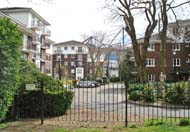Western Hospital
Seagrave Road, SW6
Medical dates:
Medical character:
Smallpox. Later, infectious diseases
In 1867 one of the responsibilities of the newly formed Metropolitan Asylums Board
(MAB) was the care and control of all pauper cases of fever and
smallpox in London. To this end, MAB began a programme of
building infectious diseases hospitals.
Erected in 1877 on part of the Lillie Bridge racing ground in Fulham, the Fulham Hospital opened with 240 beds one week before its sister hospital in Deptford (South Eastern Hospital). Both provided accommodation for the large numbers of smallpox cases during the 1870s.
However, complaints were soon heard from the neighbouring parishes of Fulham, Kensington and Chelsea that the Hospital was spreading smallpox in the vicinity. The Local Goverment Board sent a government medical investigator, Dr W.H. Power, to investigate the possibility.
Dr Power noted that the percentage of houses infected fell as the distance from the Hospital increased, and that aerial transmission was aided by stagnant air, confirming the fears of nearby residents.
A Royal Commission, which had been established in 1881 to investigate the prevailing agitation over the location of smallpox hospitals, concluded that smallpox patients should not be kept in urban areas but transferred instead to hospitals in isolated regions. In 1883 M.A.B. decided that all paupers with smallpox would be sent to smallpox ships moored on the Thames at Long Reach near Dartford.
In 1884 the Hospital became an infectious diseases hospital serving the west of London. In 1885 it was renamed the Western Fever Hospital dealing mainly with scarlet fever, enteric fever, diphtheria and typhus cases.
Additional land was purchased to the south of the Hospital in 1891 on which to erect permanent fever wards. New male and female staff blocks were also built and an additional storey added to the administration building. In 1893 three more fever blocks were added, as well as a new laundry, a mortuary and a discharge room. The Hospital then had 454 beds.
At the turn of the century, as public health measures helped to improve living conditions for the general public, the incidence of infectious diseases began to fall. However, a disease rarely reported before the 20th century began to emerge - anterior poliomyelitis (polio) - also known as infantile paralysis (as it had once mainly affected infants).
Polio quickly became one of the most feared diseases. Transmitted by the faecal-oral route, it was mainly a disease of summer when flies were likely to carry faecal contamination to food. However, instead of infants, older children, adolescents and young adults had become most vulnerable to the infection, which affected the central nervous system.
The Hospital became the receiving point for the area's cases, but nonetheless epidemics of polio did not reach the numerical heights of the other infectious diseases.
In 1921 the Hospital had 456 beds.
In 1930 MAB was abolished and the LCC took control of administration. By this time the Hospital had 14 large ward pavilions, a number of isolation blocks, an ambulance station and an administration block.
In 1933 the Hospital was chosen by the Medical Research Council to be the main stockholder of 'human convalescent serum' used in the early treatment of patients with polio. Obtained from the blood of those recovering from the disease, it was hoped to treat patients in the pre-paralytic stage of the disease before the spinal cord was infected. The serum was given intrathecally (25 ml), after 30 ml had been withdrawn by lumbar puncture, and intravenously or intramuscularly (another 25 ml).
During WW2 the Hospital joined the Emergency Medical Service with 517 beds. A First Aid Post was established on the site.
In 1948 the Hospital joined the NHS under the control of the Chelsea and Kensington Hospital Management Committee, part of the South West Metropolitan Regional Health Board. It was renamed the Western Hospital.
In the early 1950s it was proposed by the Regional Health Board to move the Metropolitan Ear Nose and Throat Hospital to the Fulham site. The Hospital objected on the grounds that its tonsillectomy patients would be in a ward block adjacent to polio patients, with a risk of cross-infection (although no heightened risk had been proved that tonsillectomy patients were especially more vulnerable to polio). In the event, in 1953 the Metropolitan Ear, Nose and Throat Hospital moved to St Mary Abbot's Hospital in Marloes Road.
In 1961 Dr. W. Howlett Kelleher, consultant physician in the Artificial Respiration Unit, introduced a modified 'iron lung' for patients with respiratory paralysis from polio. The machine rotated, enabling chest physiotherapy to be carried out in all positions.
In 1960s the 13-acre Hospital site was mooted as a possible location for the Chelsea Postgraduate Medical Centre. A model was even made of the projected complex, which included a general hospital, 12 institutes and a university building covering the Hospital lands and the adjacent railway sidings. (The scheme was never realised due to financial difficulties.)
In 1974, following a major reorganisation of the NHS, the Hospital came under the control of the South Hammersmith (Teaching) District Health Authority, part of the North West Thames Regional Health Authority.
The Hospital closed in 1979 and the buildings were demolished.
Erected in 1877 on part of the Lillie Bridge racing ground in Fulham, the Fulham Hospital opened with 240 beds one week before its sister hospital in Deptford (South Eastern Hospital). Both provided accommodation for the large numbers of smallpox cases during the 1870s.
However, complaints were soon heard from the neighbouring parishes of Fulham, Kensington and Chelsea that the Hospital was spreading smallpox in the vicinity. The Local Goverment Board sent a government medical investigator, Dr W.H. Power, to investigate the possibility.
Dr Power noted that the percentage of houses infected fell as the distance from the Hospital increased, and that aerial transmission was aided by stagnant air, confirming the fears of nearby residents.
A Royal Commission, which had been established in 1881 to investigate the prevailing agitation over the location of smallpox hospitals, concluded that smallpox patients should not be kept in urban areas but transferred instead to hospitals in isolated regions. In 1883 M.A.B. decided that all paupers with smallpox would be sent to smallpox ships moored on the Thames at Long Reach near Dartford.
In 1884 the Hospital became an infectious diseases hospital serving the west of London. In 1885 it was renamed the Western Fever Hospital dealing mainly with scarlet fever, enteric fever, diphtheria and typhus cases.
Additional land was purchased to the south of the Hospital in 1891 on which to erect permanent fever wards. New male and female staff blocks were also built and an additional storey added to the administration building. In 1893 three more fever blocks were added, as well as a new laundry, a mortuary and a discharge room. The Hospital then had 454 beds.
At the turn of the century, as public health measures helped to improve living conditions for the general public, the incidence of infectious diseases began to fall. However, a disease rarely reported before the 20th century began to emerge - anterior poliomyelitis (polio) - also known as infantile paralysis (as it had once mainly affected infants).
Polio quickly became one of the most feared diseases. Transmitted by the faecal-oral route, it was mainly a disease of summer when flies were likely to carry faecal contamination to food. However, instead of infants, older children, adolescents and young adults had become most vulnerable to the infection, which affected the central nervous system.
The Hospital became the receiving point for the area's cases, but nonetheless epidemics of polio did not reach the numerical heights of the other infectious diseases.
In 1921 the Hospital had 456 beds.
In 1930 MAB was abolished and the LCC took control of administration. By this time the Hospital had 14 large ward pavilions, a number of isolation blocks, an ambulance station and an administration block.
In 1933 the Hospital was chosen by the Medical Research Council to be the main stockholder of 'human convalescent serum' used in the early treatment of patients with polio. Obtained from the blood of those recovering from the disease, it was hoped to treat patients in the pre-paralytic stage of the disease before the spinal cord was infected. The serum was given intrathecally (25 ml), after 30 ml had been withdrawn by lumbar puncture, and intravenously or intramuscularly (another 25 ml).
During WW2 the Hospital joined the Emergency Medical Service with 517 beds. A First Aid Post was established on the site.
In 1948 the Hospital joined the NHS under the control of the Chelsea and Kensington Hospital Management Committee, part of the South West Metropolitan Regional Health Board. It was renamed the Western Hospital.
In the early 1950s it was proposed by the Regional Health Board to move the Metropolitan Ear Nose and Throat Hospital to the Fulham site. The Hospital objected on the grounds that its tonsillectomy patients would be in a ward block adjacent to polio patients, with a risk of cross-infection (although no heightened risk had been proved that tonsillectomy patients were especially more vulnerable to polio). In the event, in 1953 the Metropolitan Ear, Nose and Throat Hospital moved to St Mary Abbot's Hospital in Marloes Road.
In 1961 Dr. W. Howlett Kelleher, consultant physician in the Artificial Respiration Unit, introduced a modified 'iron lung' for patients with respiratory paralysis from polio. The machine rotated, enabling chest physiotherapy to be carried out in all positions.
In 1960s the 13-acre Hospital site was mooted as a possible location for the Chelsea Postgraduate Medical Centre. A model was even made of the projected complex, which included a general hospital, 12 institutes and a university building covering the Hospital lands and the adjacent railway sidings. (The scheme was never realised due to financial difficulties.)
In 1974, following a major reorganisation of the NHS, the Hospital came under the control of the South Hammersmith (Teaching) District Health Authority, part of the North West Thames Regional Health Authority.
The Hospital closed in 1979 and the buildings were demolished.
Present status (March 2008)
The site is mostly occupied by a pleasant public park in the centre and the gated residential 'Brompton Park Crescent' around.
The site is mostly occupied by a pleasant public park in the centre and the gated residential 'Brompton Park Crescent' around.

The original wall of the Hospital.

The gates to Brompton Park Crescent.


The park gates (left). Inside the park, looking towards the residences (right).

The park, surrounded by Brompton Park Cresent.

The ambulance station built to the north of the site.
(Author unstated) 1933 Serum treatment of poliomyelitis. British Medical Journal 2 (3783), 71.
(Author unstated) 1952 Poliomyelitis and tonsillectomy. British Medical Journal 2 (4794), 1143.
Kelleher WH 1961 A new pattern of "iron lung" for the prevention and treatment of airway complications in paralytic disease. Lancet 2 (7212), 1113-1116.
Mortimer PP 2008 Ridding London of smallpox: the aerial transmission debate and the evolution of a precautionary approach. Epidemiology & Infection 136, 1297-1305.
www.richardhill.co.uk (Accessed May 2008)
www.workhouses.org.uk
Return to home page